How Much Would It Cost To Fix a Transmission Fluid Leak In My Car?
A transmission leak can cost you anywhere from $50 to $2000 to fix, depending on what’s causing it and how bad it is. . A minor leak, requiring just a new gasket, plug, or seal, may only run you $50 to $500. Major leaks that need rebuilding or replacing the entire torque converter or transmission can cost $500 to $2000 or more. The final bill also depends on transmission and other part damage, labor rates and time required (some car models require more labor), and the specific make and model.
Noticing drops of transmission fluid under your vehicle? A transmission leak signals big repairs ahead. The repair cost of transmission often exceeds $1,000. Before panic sets in, read this guide covering average repair costs, early detection tips, and affordable solutions to stop small transmission leaks from becoming big headaches.
You can also read my guide on how long you can drive with low transmission fluid.
For your convenience, I’ve developed an interactive tool that aids in diagnosing car problems. It provides straightforward steps. Ensure to inspect it.
- A minor transmission fluid leak can cost $50 to $250 to fix, while a major leak costs $2,000 to $4,000+ to repair.
- Signs of a leak include red fluid under the car, low fluid levels, slipping transmission, and burning smells.
- Common leak causes are failed gaskets, loose drain plugs, damaged cooling lines, corroded pans, failing torque converter seals, and worn seals.
- Fixes involve replacing damaged parts, resealing pans and plugs, flushing fluids, and overhaul or replacements for serious issues.
What is the Cost Of Transmission Leaks Based On Severity?
| Type of Leak | Cost Range |
|---|---|
| Minor (seal or gasket) | $150 to $250 |
| Moderate (multiple seals, fluid flush) | $300 to $500 |
| Major (transmission overhaul or replacement) | $2,000 to $4,000+ |
What is My Personal Experience With Transmission Fluid Leaks
Once, my cousin’s 2009 Toyota Camry started showing some worrying symptoms. He noticed a reddish fluid under the car after parking and the check engine light came on. Knowing I’m handy with cars, he asked me to take a look.
After inspecting underneath, it was clear the transmission was leaking fluid. I checked the fluid level and it was quite low.
I advised him this likely meant a failed transmission pan gasket or seal. We replaced the gasket, topped up the fluid, and reset the check engine light. The leak stopped and it’s been smooth driving since
How Serious Is A Transmission Leak?
Red fluid collecting beneath your car likely signals a transmission fluid leak. This vital fluid keeps your transmission working properly. Without enough level, serious problems arise.
Your transmission relies on ample transmission fluid to function smoothly. Leaking transmission fluid leads to:
- Low fluid levels
- Slipping transmission
- Loss of power
- Hard shifts
- Whining noises
- Burnt odors
Low transmission fluid also causes overheating, damaging internal components. Left unchecked, a small leak becomes a transmission failure.
Signs requiring a transmission service include:
- Red puddle below the center or front of car. Transmission fluid is red unlike other automotive liquids.
- Dipstick reading transmission fluid level below the minimum mark. Check under the hood.
- Delayed/harsh gear changes. Transmission slips out of gear.
- Humming or whining noises when operating. Signals transmission overheating issues.
- Burnt smell emanating while driving. Transmission fluid breakdown leads to poor lubrication.
- Limp mode activation. Speed/power limited to prevent further damage.
If you are not observing clear signs of transmission fluid leak but it is still getting low, you can read my guide on that topic.
What are the Causes of Transmission Fluid Leak and Cost To Fix Them?
1. Worn Transmission Pan Gasket Causing Transmission Fluid Leaks
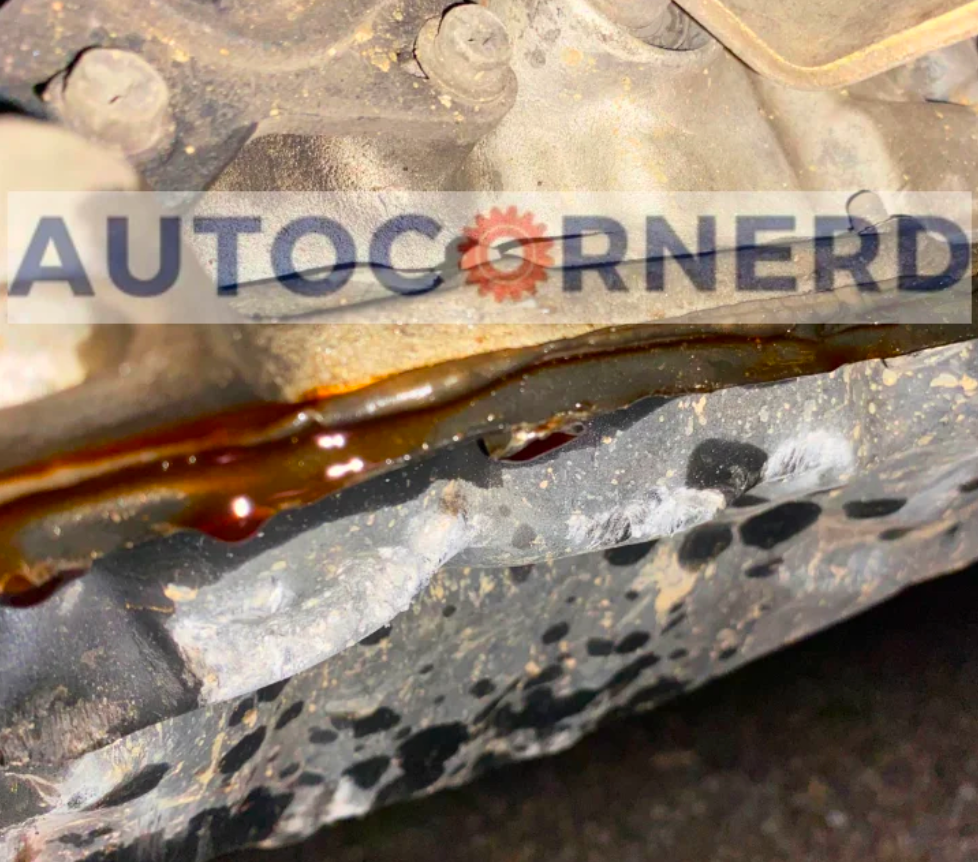
The transmission pan gasket seals the deal. This thin slice of material sits snug between the pan and housing, keeping that precious transmission fluid where it belongs. But when this gasket gets damaged, transmission fluid leaks happen, and that’s bad news for your ride.
Why the wear and tear? Time takes its toll. As the gasket ages, exposure to engine heat makes it brittle and cracked. Tiny fissures form, opening the door for drips and drops. Ruh-roh!
Improper installation also wrecks the seal. If the gasket’s alignment goes out of whack during a repair, transmission fluid seeps out through the gaps.
And if those transmission pan bolts get cranked down too tight? The gasket gets smooshed and deformed, warping its shape. Leaky leaks follow.
Cost to fix?

Fixing a leaking transmission pan gasket is a straightforward repair that you can do in your garage. The cost depends on the type of vehicle, but expect to pay $100-$300 for parts and labor.
Here are the key steps:
- Lift up your vehicle so you can access the transmission pan underneath.
- Drain the old transmission fluid from the pan. You can remove the drain plug or loosen the pan bolts.
- Take off the old gasket. Use a scraper or solvent to clean the mating surfaces on the pan and transmission case.
- Give the transmission pan a good cleaning too. An engine degreaser works well to remove oil, dirt and old gasket material.
- Put a thin bead of RTV silicone sealant on the transmission pan before installing the new gasket. This helps it stick in place. But don’t use too much.
- Carefully set the new gasket onto the pan. Line up the bolt holes. Let the adhesive set partially before tightening.
- Reattach the transmission pan to the transmission case. Tighten the bolts crisscross style.
- Refill the transmission fluid as specified by your vehicle manufacturer.
- Start the engine and check underneath for any leaks.
Here are the costs of the steps involved in fixing the transmission pan gasket:
| Step | Cost (Estimated Range) |
|---|---|
| Inspection and Diagnosis | $50 – $100 |
| Drain Transmission Fluid | Included in Repair Price |
| Remove and Replace Gasket | $20 – $80 |
| Replace Filter (if necessary) | $20 – $50 |
| Refill Transmission Fluid | Included in Repair Price |
2. Loose Drain Plug Allowing Leak From Transmission
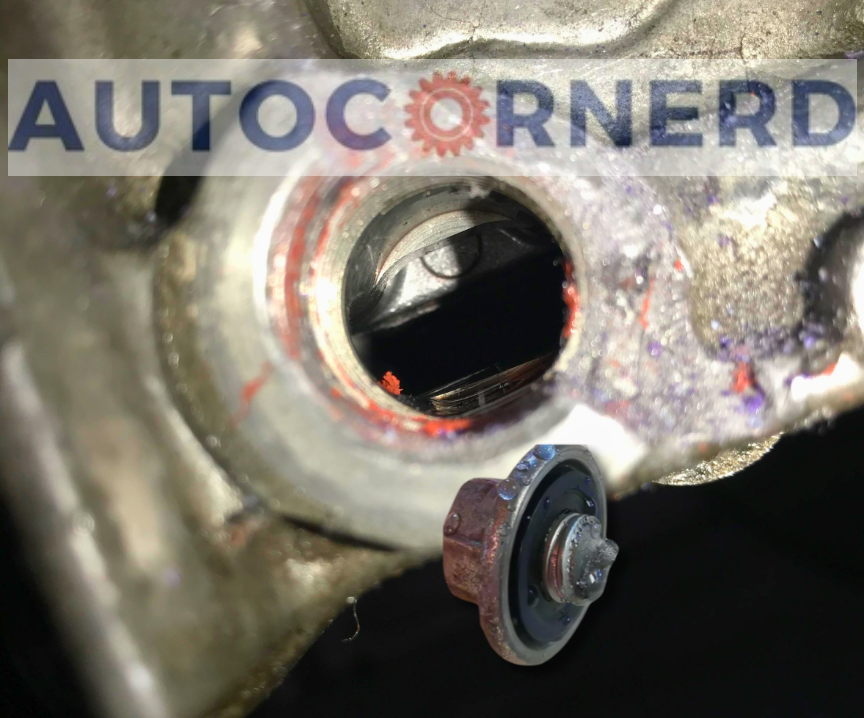
The transmission drain plug is located at the bottom or side of the transmission casing. Its job is to allow old fluid to drain out when it’s time for a transmission service.
Unfortunately, these little plugs don’t last forever. Over time, they can become stripped or loose.
How does this happen?
Too much tightening, cross-threading during installation, corrosion from road salt, or just wear and tear can damage the threads.
When the drain plug is not secured properly after a fluid change, or its threads are too worn to make a tight seal, transmission fluid leaks out.
How to fix?
Don’t ignore leak signs like low fluid levels or spots on your driveway. And watch for a drain plug that feels loose or wobbly, seems hard to turn, or has visible thread damage.
A transmission drain plug is cheaper to replace than fixing a moderately stripped transmission drain plug using a tap-and-die set. A new transmission pan drain plug will only cost from $10 to $50.
3. Damaged Transmission Cooling Lines Leading to Leaks
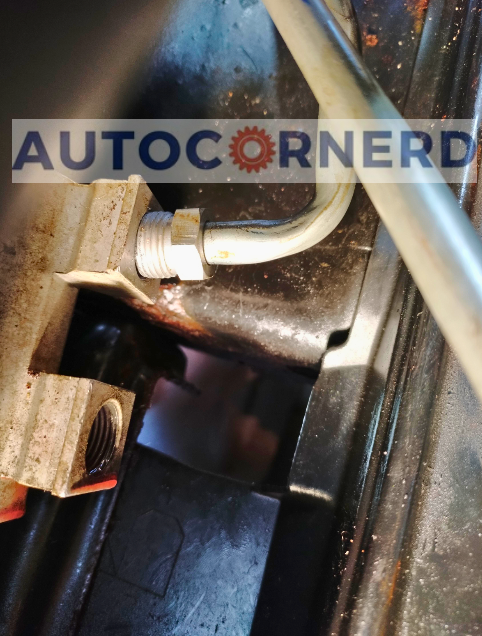
The car’s transmission needs a specific fluid to work properly. This special transmission fluid flows through lines that connect the transmission to the radiator. The radiator cools down the hot fluid before it goes back to the transmission.
This cooling process keeps the temperature of the transmission fluid just right. If the transmission fluid gets too hot, it can ruin the transmission and cause problems like leaks or wear and tear over time.
There are a few common reasons the transmission cooling lines might spring a leak:
- Rust: The metal lines can get rusty or corroded if exposed to moisture, dirt or road salt. This can make holes or cracks that leak fluid.
- Wear: The rubber or plastic hoses connecting the lines to the transmission and radiator can crack from heat, bending, or old age. Then they lose fluid.
- Damage: If the car gets in a crash or hits something in the road, it can bend, kink or poke holes in the cooling lines. This messes up the fluid flow and causes leaks.
- Installation: If the cooling lines aren’t put in correctly, they might be loose, out of alignment, or get damaged. Then they leak or don’t work right.
How much cost to fix?
On average, you can expect to pay between $100 and $500 for replacing transmission cooling lines. The parts alone can cost between $50 and $200, while the labor can cost between $50 and $300.
Here is a table mentioning the steps with their cost to fix transmission cooling lines leakage:
| Step | Cost |
|---|---|
| New transmission cooling lines or hoses | $50 – $200 |
| New fittings, o-rings and clamps | $10 – $20 |
| Transmission fluid | $20 – $50 |
| Labor | $50 – $300 |
| Total | $100 – $500 |
Note: Some vehicles have separate transmission cooler and radiator, and some have transmission cooling lines connected to the bottom part of the radiator. So, it entirely depends on the make and model of your vehicle.
4. Rusted Transmission Pan Bolts Causing Cracks & Leaks
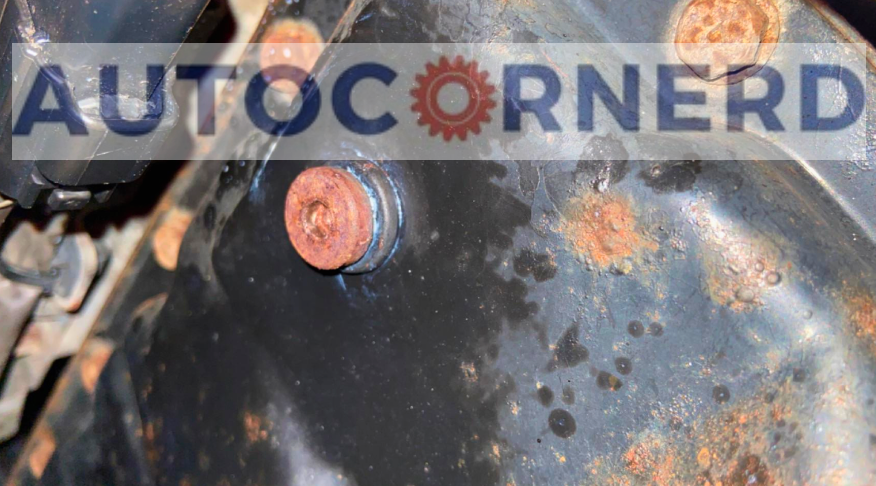
The transmission pan sits at the bottom of your vehicle’s transmission, acting as a reservoir to collect fluid and prevent leaks. But even this sturdy metal pan can become damaged over time.
Two common issues can crop up with transmission pans after miles on the road:
- Warped Mating Surface: The mating surface is the flat section on the bottom of the pan that seals against the gasket and transmission case. If impacted by road debris or installed improperly, this surface can warp and bend. Gaps then form, allowing fluid to drip out slowly.
- Rusted Bolts: The pan attaches firmly to the transmission case using several bolts. But exposure to rain or condensation introduces moisture. This moisture causes the metal bolts to corrode and rust over time. The weakened bolts can shear off entirely, preventing removal of the pan.
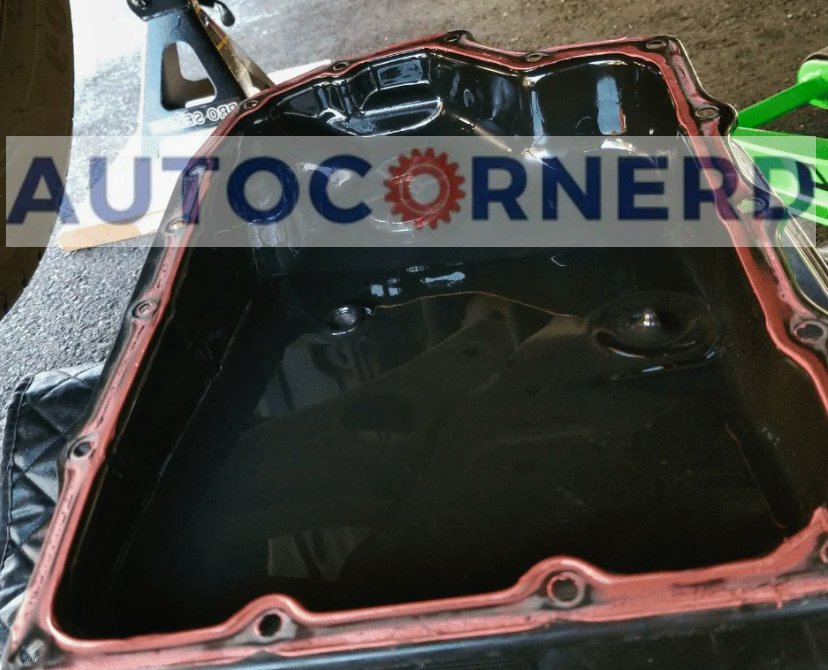
Do you know that oil pan can also cause leakage if warped? You can read my guide on that topic to learn more.
How to fix?
Once the old pan and bolts are off, installing the new pan with fresh bolts is straightforward. Just make sure the mating surface is clean for a tight seal.
Overall, you can expect to pay $100 to $400 for parts and labor to replace a damaged transmission pan and rusted bolts.
You simply can’t hammer transmission pan to put it back into shape. The stubborn bolts of transmission price can drive up the price, but it’s cheaper than a busted transmission!
5. Failing Torque Converter Seal Resulting in Leaks
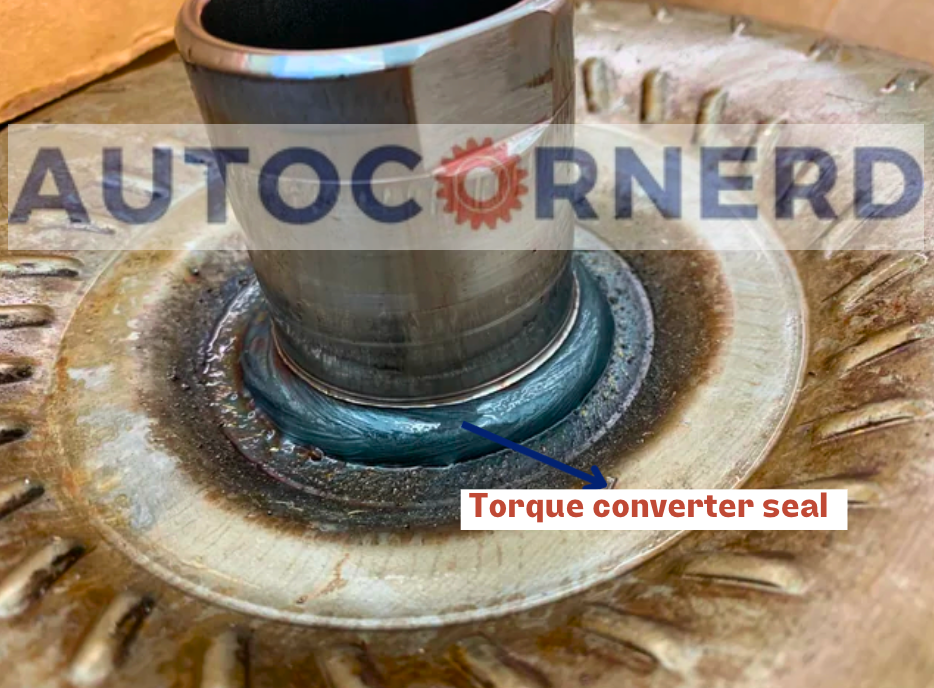
A torque converter is a fluid coupling that connects the engine to the transmission. It is made up of three main components: the impeller, the turbine, and the stator.
The impeller is connected to the engine and spins the fluid around inside the torque converter.
The turbine is connected to the transmission and receives the spinning fluid from the impeller. The stator sits between the impeller and the turbine and helps to redirect the flow of fluid.
If you want to understand, how the transmission fluid flows from the transmission pump to the torque converter through the input shaft, you should watch the following video:
The torque converter is the heart that keeps a transmission pumping. Like any other complex machine, it can break down over time and cause leaks. Remember these key failure points:
- Seals wear out. A torque converter has several seals to hold fluid inside. As it ages, they lose flexibility and fail.
- Too much friction overheats parts. Constant high speeds and loads grind down bearings, bushings and other internals of torque converter. Cracks let transmission fluid escape.
- Cracks spider through the shell. Impacts or stress can fracture the sturdy torque converterconverter casing. Once compromised, leaks begin.
- Impeller and turbine distort. These two elements circulate transmission fluid within the torque converter converter. If worn or damaged, pressure imbalances lead to leaks.
- Improper installation misaligns everything. Unless bolted to exact torque specs in perfect alignment, the torque converter and transmission mate poorly.
Cost to fix?
On average, you can expect to pay between $600 and $1000 for replacing a torque converter seal. however, this is only an estimate and your actual cost may vary depending on your specific situation.
Here’s a table showing all steps with a cost for fixing a failing torque converter:
| Step | Cost |
|---|---|
| Drain transmission fluid | $20-$50 |
| Remove torque converter | $300-$500 |
| Replace seal | $10-$20 |
| Reinstall torque converter | $300-$500 |
| Refill transmission fluid | $50-$100 |
| Total | $680-$1170 |
6. Broken Seals in Transmission Allowing Fluid Leaks
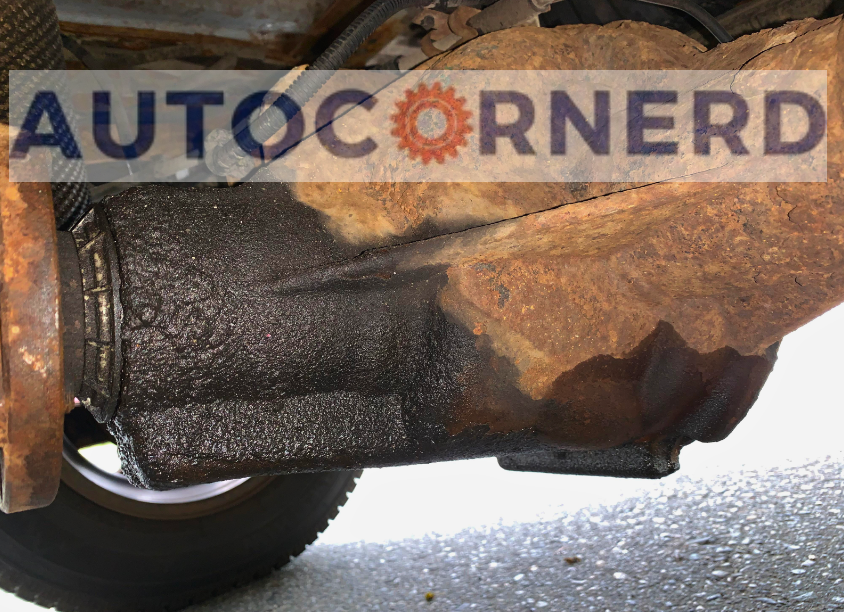
Automatic transmissions work like a team, with many parts working together. Seals are one of these team players, used throughout the transmission. Their job is to maintain the right fluid pressure, reduce friction, and prevent leaks. Transmission seals are made of rubber and plastic. Some even have steel inside for reinforcement.
Over time, oxidation can make rubber and plastic seals stiff and cracked. This leads to leaks. Seals can also fail early if they aren’t put in correctly. And if there’s wear on the transmission’s bearings, this damages the seals and causes leaks too.
Seals are found in a few key spots in automatic transmissions. Here’s a look at where they are and how they help:
- Input and Output Shaft Seals: The input and output shafts have a big job – they transfer power from the transmission to the wheels. To prevent leaks and keep fluid pressure right, seals are used on both shafts. The transmission pump seal, rear output shaft seal, and front input shaft seal are common examples.
- Transaxle Seal: A transaxle combines a transmission, differential, and axle in one. The transaxle seal sits at the end. It keeps transmission fluid from leaking out of the transaxle.
- Fluid Filter Screen Seal: The fluid filter screen seal is at the bottom of the transmission case. It connects to the fluid filter screen assembly. This seal prevents leaks between the case and filter screen. The seal is typically rubber or plastic with metal inside. It uses a lip to contact the filter screen assembly.
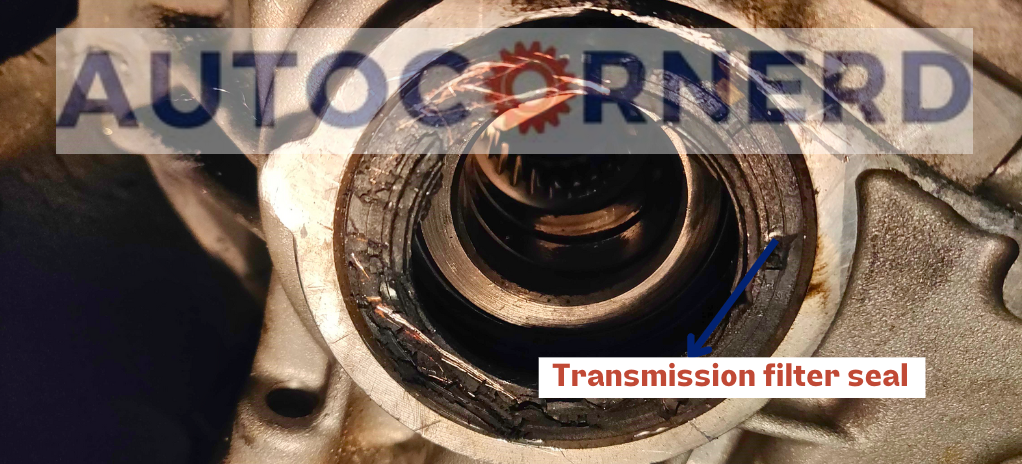
Here is a short video about transmission filter seal:
Cost to fix?
Transmission seals can cost between $10 and $20 for the part and between $100 and $300 for the labor.
7. Leakage Through Transmission Fill Plug
The fill plug is a little bolt on the transmission housing. It lets you add or check the transmission fluid. Many vehicles today don’t have a dipstick to check the fluid level. They use the fill plug instead.
The fill plug threads can get damaged or worn down over time. This can make the plug loosen and start leaking fluid. If you don’t tighten the fill plug enough when you put it back in, it can leak too.
Or if you cross-thread it going in, it can cause a leak. It’s really important to line up the fill plug just right and tighten it to the right torque specs. This keeps leaks from happening.
How much cost to fix?
If the fill plug of the transmission is corroded, it will cost around $20 to $50 to replace the fill plug.
Final Thoughts
The vehicle’s transmission seals the fluid inside, keeping everything running smoothly. But over time, those seals and gaskets wear down, opening up tiny gaps that let the fluid trickle out slowly.
Ignoring transmission leaks is never wise. The drips will only grow worse, demanding repairs sooner or later.
Catching problems early makes fixes cheaper. Prices run the gamut based on where the transmission fluid sneaks out and how badly. Minor leaks of a few drops of transmission fluid might cost a mere $50 patch job.
But if the entire transmission pan seal gives way, expect a $500 bill to set things right. Either way, it’s nothing compared to replacing an entire fried transmission.
So keep an eye out beneath your vehicle. If you spot red fluid pooling on the driveway, have it checked immediately. The quicker that leak gets plugged up, the less you’ll pay down the road.
Some First Hand Experiences Shared By Users In Different Communities
Our team conducted research across various online communities, forums, and subreddits to gather user comments and opinions on “cost to fix transmission leak”.
User 1 says:
Noticed a small leak under my RAV4. It was a transmission fluid line that had come loose. Fixed it for around $200, including labor and topping up the fluid.
User 2 says:
My Jetta’s transmission was leaking from a bad gasket. Found out when I saw a stain on my parking spot. The fix was around $300, including replacing the gasket and transmission fluid.
User 3 says:
I had a leaky transmission seal on my CX-5. Noticed it when my transmission started slipping. The repair was pricey, around $550, but that included a complete fluid change.
User 4 says:
The transmission line got punctured on my Traverse, probably hit something on the road. Found out after seeing a red fluid leak. The repair, including replacing the line and refilling the fluid, was about $450.
User 5 says:
Had a transmission cooler line rupture on my Rogue. First saw a spot on the garage floor, then the transmission started overheating. Repair cost me around $400, including new lines and fluid.
